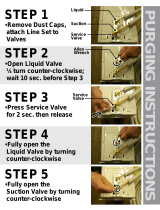
2
TABLE OF CONTENTS
Page
SAFETY INSTRUCTIONS ......................................................................................................................................... 2
INTRODUCTION ........................................................................................................................................................ 2
PRECAUTIONS FOR OPERATION .......................................................................................................................... 3
INSTALLATION, PIPING AND WIRING .................................................................................................................... 4
BLEED VALVE INSTALLATION (Optional) ............................................................................................................... 6
CURRENT INTERRUPTOR (Optional) ...................................................................................................................... 7
MAINTENANCE ......................................................................................................................................................... 8
SERVICE AND REPAIRS .......................................................................................................................................... 9
TROUBLESHOOTING ............................................................................................................................................. 10
PARTS LIST (EXPLODED PUMP ASSEMBLY) ...................................................................................................... 11
REPLACEMENT KITS (EXPLODED WET END ASSEMBLY) ................................................................................ 12
SAFETY INSTRUCTIONS
READ ALL INSTRUCTIONS PRIOR TO USE
Secure chemicals & metering pumps, making them inaccessible to children & pets.
*** DO NOT PUMP FLAMMABLE LIQUIDS.
*** Do not cut the plug or ground lug off the electrical cord. Consult a licensed electrician for proper installation or
replacement.
To reduce the risk of electrical shock-before maintenance, repair, or moving, always disconnect the power
to the pump by unplugging from wall outlet.
Always wear protective clothing, including gloves and safety glasses, when working on or near chemical
metering pumps.
** Inspect tubing regularly for cracking or deterioration and replace as necessary. (Always wear protective clothing and
safety glasses when inspecting tubing.)
** Use CAUTION to keep fingers away from rotating parts.
** If pump is exposed to direct sunlight, use a UV resistant tubing.
** Follow directions and warnings provided from the chemical manufacturer. The user is responsible for determining the
chemical compatibility with the chemical feed pump.
** Make sure the voltage on the pump name tag matches the installation voltage. If pump fails to start, check line voltage.
** Consult with local health officials and/or qualified water conditioning specialists when treating potable water.
** Always depressurize system prior to installation or disconnecting the metering pump tubing.
** If injection point is lower than the chemical tank and pump, install an anti-siphon valve.
** DO NOT MODIFY PUMP. This poses a potentially dangerous situation and will void the warranty. Hand tighten plastic
connections (Do not use wrench).
All pumps are factory tested with water. Remove tubing and thoroughly dry if the chemical being pumped
will react with water (for example sulfuric acid).
* Hand tighten plastic connections (Do not use wrench).
* Consult licensed plumber and electrician before installation to conform to local codes.
* NOTE: For accurate volume output, pump must be calibrated under all operating conditions.
INTRODUCTION
Series 100/150 are diaphragm-type metering pumps. A fluid is pumped from a
chemical storage tank to the point of injection by the pulsing action of the
diaphragm. The four check valves (top and bottom of pump head, strainer
assembly, and injection assembly) keep the fluid flowing toward the point of
discharge. To insure the solution being pumped can only go forward, it is
important that all check valves provide positive, non-leaking backflow
prevention. The wetted end (those parts that contact the solution being
pumped) is constructed of SAN, PVC, TFE, Hypalon®, and polyethylene.
These materials are very resistant to most chemicals. However, there are
some chemicals, such as strong acids or organic solvents, which cause deterioration of some elastomer and plastic parts,
such as diaphragm, valve seat, or head. Alternate materials such as Viton®, polypropylene is available on request.
Contact chemical supplier for chemical compatible materials.
NOTE: Prime Performance Series Addendum starts on page 13
















